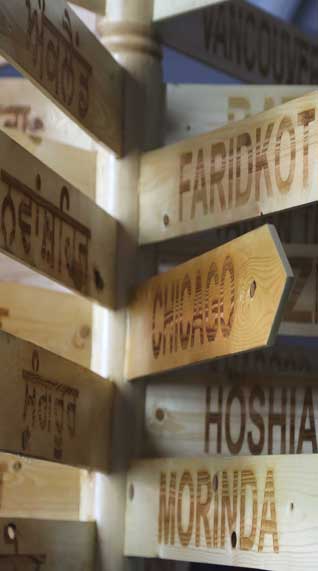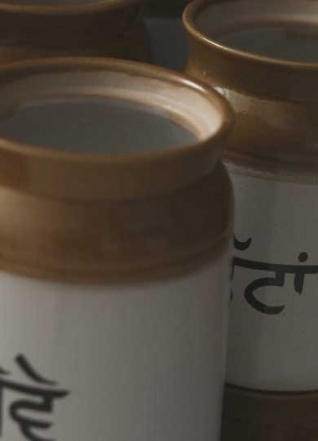Current Events
A Spotlight On Gurmukhi In This Year’s Mela Phulkari
NEWS REPORT
April 6 - 13, 2017
New Delhi
It’s that time of the year again when Punjabis across the country congregate for a unique extravaganza in New Delhi.
Mela Phulkari, a one-of-its-kind festival put together by the Sikh/Punjabi concept store “1469“, is back in its fourth avatar.
Curated by art historian and cultural theorist Dr Alka Pande, Mela Phulkari, held at the India Habitat Centre’s Open Palm Court, has in the past three years brought alive the rich culture of Punjab with some fascinating installations, artworks and exhibits of the exquisite Phulkari weaves by rural Punjabi women.
Mela Phulkari IV takes the art of preserving Punjabi heritage a step further by saluting the origin and journey of the Gurmukhi script that was born in Goindwal in Punjab almost five centuries ago. The Mela is an ode to the cultural enrichment of Punjab through the script entwined into various facets of the daily lives of the people.
Summarising the theme beautifully, the curator Alka Pande says: “For 2017 we decided to take yet another cultural metaphor under the large umbrella of Phulkari. This time we decided to explore the beauty of the written word through the simple beauty of the Gurmukhi script.”
The origin of the Gurmukhi script is attributed to the Second Master, Guru Angad Sahib.
Some of the main highlights of the Mela:
1 ‘Qandh - The Great Wall’ by graphic artist Orijit Sen. The mural of life in Punjab depicts the indomitable spirit of Sikhs and Punjabis over the years.
2 ’Neev - The Foundation’ by Harinder Singh is an ode to the great literary figure, Bhai Kahn Singh Nabha, the man who gave us the Mahaan Kosh, a work that modestly claims in its title to be an Encyclopedia of Sikh Literature. Its remarkable coverage and exemplary accuracy has 64263 entries of brief definitions of words, even obscure and historical ones, from Gurmukhi/Punjabi. It paves the foundation to all literary work in the language.
3 ‘GT Road’ (Grand Trunk Road) by Jassi Sangha and Gurjeet Singh with a display of 101 robust jars (Martaban) that have typical names of Punjabi food articles written on them.
4 ’Raagmala’ by Harinder Singh and Jagdeep Singh. This installation boasts over 31 Nanakshahi bricks celebrating the musical journey of the verses in the Guru Granth Sahib. The 31 raagas used in our Scripture are calligraphed on the
Nanakshahi ‘ittaan‘. This variety of brick tiles were historically of moderate dimensions and could be used for reinforcing limestone and concrete in the structural walls and other thick components.
5 ‘Samrala Chowk’ by Harinder Singh and Bhupinder Singh. An ode to the diaspora from Punjab that has dispersed to all parts of the world but have kept their Punjabiyat alive.
6 ‘Kitaab - The Installation’ is a collection of manuscripts by Punjab Digital Library, which is a voluntary organisation digitizing and preserving since 2003 the cultural heritage of Punjab. The PDL collection includes manuscripts dated from the early fifteenth century, making it the biggest resource of digital material on Sikhs and Punjab, with over 15 million digitized pages.
7 ‘Sangrur Bell’ by Ghazala Khan & Kirandeep Kaur This is an installation of 2500 sangrur bells. This miniature phulkari accessory is symbolic of the efforts to empower the women of rural Panjab.
8 ’Kareen kitey mail rabba, Dilli te Lahore da …” by Gurjeet Singh, is an installation about the beginnings of the Puanjabi language in pre-historic times, the development of the Gurmukhi script, and later its bifurcation into Shahmukhi and Gurmukhi. Shahmukhi is written from right to left, following its Arabic origins, while Gurmukhi is written from left to right.
9 ‘Barahmaah Blocks’ of the 12 months of the Punjabi calendar artistically engraved on wooden blocks with Phulkari patterns in the backdrop.
10 ‘Soney di Savair’ - Gold Rush, by Harinder Singh & Hashim Saifi. This installation is a depiction of a typically vivid Punjabi morning a golden bicycle carrying traditional (golden) milk utensils.
11 ‘Ikk meri akh kashni’ Phulkari, by Harpreet Sokhi, is inspired from the traditional Punjabi song with the same words.
12 Interactive Gurmukhi Calligraphy, by Gurjeet Singh.
For more info, please CLICK here.
March 30, 2017




